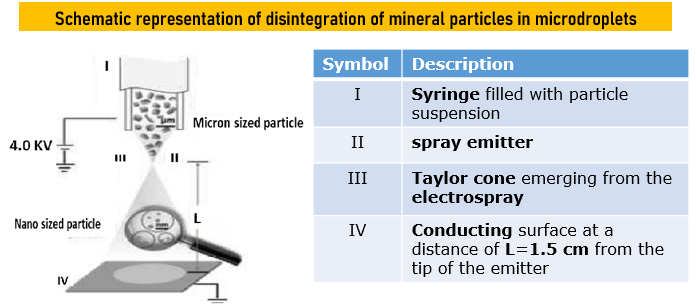Industrial Consultancy & Sponsored Research (IC&SR) , IIT Madras
A Method to Transform Crystalline Minerals to Nanoparticles by Microdroplets
Categories for this Invention
Technology: Transform Crystalline Minerals to Nanoparticles
Category: Nano Research
Industry: Soil Testing/Nano particles
Application: Mining Process, Soil health management.
Market: The global market size was valued at USD 4679.88 million in 2022 and is expected to expand at a CAGR of 5.65% during the forecast period, reaching USD 6507.29 million by 2028.
Image Gallery
Problem Statement
- Soil is formed by the weathering of rocks.
- While physical, chemical, and biological weathering occurs.
- The process of soil formation is slow, taking millions of years.
- There is a need for breaks the common minerals such as quartz and ruby to nanoparticles in micro droplets.
- Microdroplets are known to cause chemical synthesis at an accelerated rate or convert large protected nanoparticles of 10-50 nanometer in diameter to smaller ones of 3-5 nanometer in diameter.
Technology
Method:
A Method to Transform Crystalline Minerals to Nanoparticles, Comprises
- Grinding crystalline minerals to obtain particles in
- ~1-5 micrometer scale;
- Mixing grinded particles in distilled water
- to form a suspension of particles;
- Spraying the charged microdroplets of
- 0.1 mg/ml suspended particles at spray potential
- in the range of 4 kV through a 50 μm inner diameter capillary
- at a flow rate of 0.5 ml/h onto the substrate at a distance of 1.5 cm from the tip
- Collecting the nanoparticles from the substrate;


Key Features / Value Proposition
Minerals to Nanoparticles
- Charged micro droplets can break common minerals such as quartz and ruby to nanoparticles.
- Electrospraying of particles leading to the formation of nanoparticles.
- Electrospray produces nearly uniform nanoparticles upon optimizing the conditions
Source of materials
- Natural minerals
Microdroplet medium
- Water
Resultant sizes
- 5-10 nm
- Size changes (From starting to final product)
- Micron particles to Nanoparticles
Technical specifications
- 4.0 kV applied potential
Do not use
- Stober’s process and microemulsion method
- eternal laser power
- sol-gel method.
Method is simple and used ambient microdroplet synthesis.
Questions about this Technology?
Contact For Licensing
sm-marketing@imail.iitm.ac.in
ipoffice2@iitm.ac.in
Research Lab
Prof. Pradeep T
Department of Chemistry.
Intellectual Property
- IITM IDF Ref. 2388
- Patent No: IN 539562
- PCT No: PCT/IN2023/050649
Technology Readiness Level
TRL-4
Experimentally validated in Lab;
